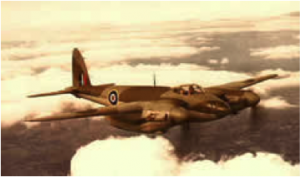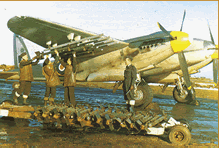WW2 and Commonwealth Plywood.
What’s the connection?
On the 30th of January 1943, the commander of the Luftwaffe and World War I hero, Herman Göring, was scheduled to make a radio speech on the 10th anniversary of Adolf Hitler’s ascent to power in Nazi Germany. As Göring was introduced, nearby explosions forced postponement of the broadcast. The explosions were caused by bombs dropped from three “super fast” twin-engine Mosquito bombers on the occasion of the first allied daylight raid of World War II (WWII) on the German capital. This occasion must have been painfully embarrassing to Göring who had once boasted that no British aircraft would ever bomb Germany. Lord Haw Haw, a German propaganda broadcaster, passed the raids off to British listeners as…”thanks to the U-boat campaign. Britian is so wanting for material that she has been compelled to build her bombers of wood.”
It was only through the perseverance of Geoffrey de Havilland, an early aircraft pioneer, and the encouragement and support of Air Chief Marshall Sir Wilfrid Freeman that the Mosquito was built. The proposal by de Havilland of a bomber that could fly as fast as a fighter with a range that would reach Berlin and back was turned down by the British Air Ministry because it was perceived that no modern military aircraft could be built of wood.

Freeman and de Havilland convinced the Air Ministry to proceed only because the wooden aircraft would not be constructed of a vital war material. De Havilland was so confident in the concept that his own son was the first test pilot. Young Geoffrey de Havilland flew the prototype across the British countryside on the 20th of April of 1941 with General Hap Arnold of the United States in attendance. The Mosquito reached 408 mph in level flight, which was faster than the operational version of the Spitfire at the time, whose top speed was 370 mph. After this demonstration flight, the airplane almost failed its acceptance for the Royal Air Force. In one trial the test pilot heard a disturbing noise in the rear of the plane. On landing, it was found that a piece of the wood had broken in the fuselage. To the astonishment of onlooking experts, the de Havilland ground crew put in a new spruce structural member and patched the cracked fuselage with plywood.
The prototype went on to pass the acceptance trials with flying colors. The 8,000 Mosquitos built in WWII consumed large quantities of balsa, Canadian yellow birch and Sitka spruce. When supplies of high quality wood became scarce, Douglas fir and English ash were sometimes substituted.
Like all other aircraft, the mosquito was not perfect. It tended to be susceptible to incendiary bullets; however, it exhibited an ability to take tremendous punishment from conventional flak. It was simple to repair and easy to fly. It was an aircraft for airmen who affectionately referred to it as the “Mossie”. Group Captain Basil Embrey, a heavily decorated flyer of WWII, later to become Air Chief Marshall Sir Basil Embrey, described the Mosquito as “the finest aeroplane, without exception, that has ever been built in this country.”
In 1941, the Mosquito was the fastest operational military aircraft. Colonel Elliot Roosevelt of the U.S., after flying a Mosquito, wanted to trade a squadron of his P-38 Lockheed Lightning fighters for a squadron of Mosquitos. The Russians wanted to build a factory to manufacture the bombers. On several occasions it was proposed by the Americans that Mosquitos be swapped for either P-38 Lightnings or the P-41 Mustangs. Air Marshall Freeman vetoed these swaps because of demand for the aircraft by the RAF and because he felt America possessed no plane worth swapping for the Mosquito.

The Mosquito is generally believed to be the most versatile military aircraft of WWII, possibly of all time. While the plane was designed as a light bomber, versions of the aircraft were designed for day and night fighters, for photographic reconnaissance, and for path finding. Path finding aircrafts were designed to precede raids by the British and American four-engine heavies. Path finders flew at low altitudes and dropped flares to help the slower more vulnerable heavy bombers locate their targets.
General Bernard Montgomery, on several occasions during the African and European campaigns, made specific requests for Mosquitos to support the British Eight Army because of his confidence in the aircraft.
